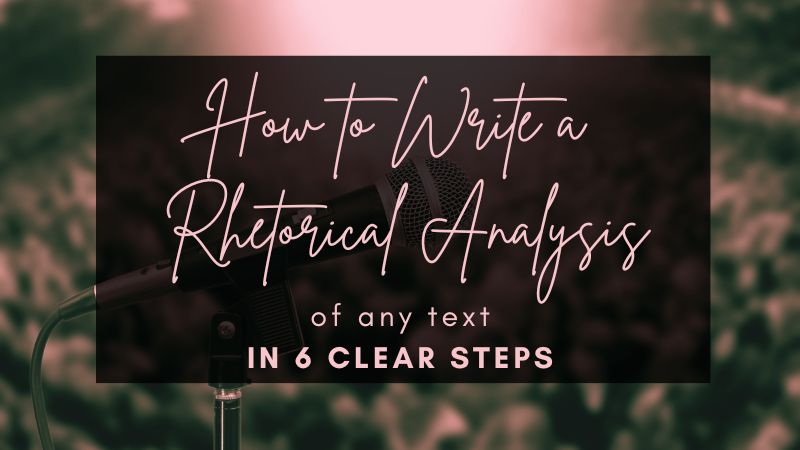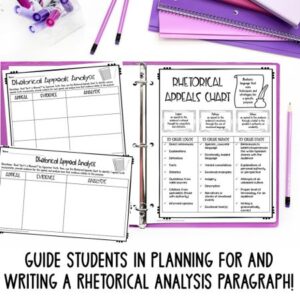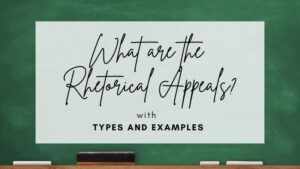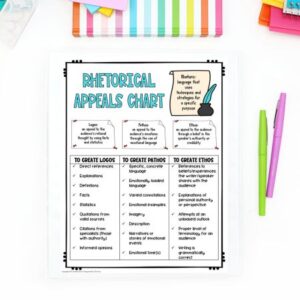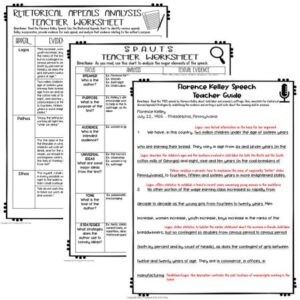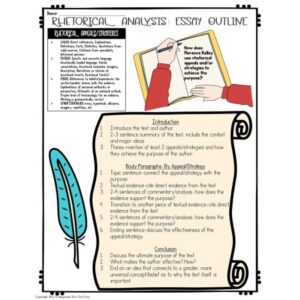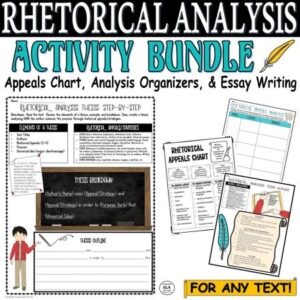Rhetorical Analysis, on the surface, seems super complex and completely overwhelming, especially if you have never been exposed to it before. More often than not, when we ask students to write a rhetorical analysis of any text we are teaching, they might feel blindsided, confused, and anxious.
These reactions come about because of several reasons:
- They have never heard the word “rhetoric” let alone “rhetorical analysis” before.
- The only essays they have written so far have been narratives, expositions, argumentations, research, and maybe literary analysis.
- The thought of learning how to do a critical examination and evaluation of a text requires more than simple comprehension skills.
If you want to wade through the process of teaching students how to write a rhetorical analysis of any text of your choice, keep reading How to Write a Rhetorical Analysis of ANY Text in 6 Clear Steps!
Need help with Test Prep? Check out this FREE Pack of 3 Test Prep Activities to help students achieve success on standardized tests!
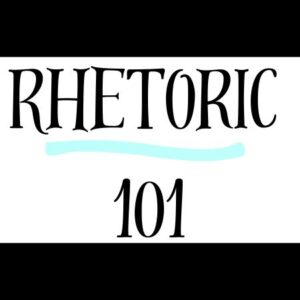
How to Write a Rhetorical Analysis of ANY Text in 6 Clear Steps
There are so many ways to go about teaching rhetorical analysis of higher-level texts, so it is critical to ease students into the process. Take your time, and don’t expect a full essay in a day or even a week. If you are committed to the process, teaching a rhetorical analysis unit should take about 3-4 weeks as you read many passages, analyze rhetoric in many formats, and assign a full-length essay. Below are 6 steps to help you in this process.
1. Introduce the rhetorical situation.
The rhetorical situation includes the identification of the rhetor, audience, purpose, topic, and context.
A. Rhetor-creator of the rhetoric
Questions to consider:
1. Who produced the rhetoric?
2. How might you describe the rhetor?
3. What do you know about the history of the rhetor?
B. Topic-the major ideas/subjects within the rhetoric
Questions to consider:
1. What are the major ideas in the rhetoric?
2. Why might these ideas be important to the rhetor?
3. How might the rhetor approach this topic?
C. Audience-intended receiver of the rhetoric
Questions to consider:
1. Why did the rhetor choose this specific audience?
2. How might the audience be described?
3. Could there be more than one type of audience and why?
D. Purpose-what the rhetor hopes to accomplish
Questions to consider:
1. Why did the rhetor choose this specific audience?
2. How might the audience be described?
3. Could there be more than one type of audience and why?
E. Context-the situation bringing about and surrounding the rhetoric
Questions to consider:
1. What are the features of the situation?
2. What circumstances have affected the rhetoric’s development?
3. What societal, cultural, and environmental elements might be influential?
2. Practice Identifying the elements of the Rhetorical Situation.
You can practice with ANY text, but I would start with a shorter speech like Sojourner Truth’s “Ain’t I a Woman?”.
Sojourner Truth: Ain’t I A Woman?
Delivered 1851
Women’s Rights Convention at Old Stone Church in Akron, Ohio
Well, children, where there is so much racket there must be something out of kilter. I think that ‘twixt the negroes of the South and the women at the North, all talking about rights, the white men will be in a fix pretty soon. But what’s all this here talking about?
By reading the above information, we can begin to get a sense of certain elements like the rhetor, the audience, the context, and the topic. We also start to understand her purpose.
If you want easy-to-implement rhetorical analysis activities for “Ain’t I a Woman?” then click below!
Additionally, you could have students practice the rhetorical analysis of ads, watch videos, or analyze art/photographs with a focus on the rhetorical situation before reading more demanding texts.
The goal is to make the process more relatable and accessible!
3. Explain these concepts: Rhetorical Appeals and Other Rhetorical Strategies.
Rhetorical Appeals refer to Logos, Pathos, and Ethos.
Read more about the 3 Rhetorical Appeals below!
Rhetorical Strategies could refer to any technique a rhetor uses to achieve her/his purpose.
- Repetition
- Alliteration
- Figurative Language
- Metaphor
- Simile
- Hyperbole
- Understatement
- Oxymoron
- Irony
- Allusion
- Tone
- Imagery
- Rhetorical Question
- Point of View
- Comparison
- Contrast
- Diction
- Syntax
Don’t assume students know these ideas; make sure to define and give examples of the ones you want your students to examine. You don’t have to teach every term!
Here are some speeches and historical texts you could practice on:
- “A Modest Proposal”
- “Declaration of Independence”
- Florence Kelley Child Labor Speech
- “Declaration of Sentiments”
- “Gettysburg Address”
- “Ain’t I a Woman?”
- “Sinners in the Hands of an Angry God”
- “Give Me Liberty or Give Me Death”
Make your planning time a bit easier by checking out this Rhetorical Analysis of Historical Texts BUNDLE!
4. Annotate for Purpose & Rhetorical Appeals/Strategies.
Modeling how to locate effective strategies for a rhetorical analysis of a speech, for example, might look like underlining evidence that helps to support the rhetor’s purpose and THEN identifying the strategy used.
If a rhetor uses a metaphor, but it doesn’t add to the text’s effectiveness, there is no point in mentioning it. Simply put, we have to be able to make an observation about the strategy’s use and relevance.
Here is an excerpt from Susan B Anthony’s “Woman’s Rights to the Suffrage” speech:
The only question left to be settled now is: Are women persons? And I hardly believe any of our opponents will have the hardihood to say they are not. Being persons, then, women are citizens; and no State has a right to make any law, or to enforce any old law, that shall abridge their privileges or immunities. –from the speech Woman’s Rights to the Suffrage by Susan B Anthony
We have the rhetorical question in “Are women persons?” I can definitely see a connection to her overall purpose.
I also see the use of alliteration in an emphasis on the root “hard,” which I could link to the plight of women.
We really want to help students see the most effective strategies employed by the rhetor!
Make writing about Kelley’s Child Labor Speech simple and clear for your students! Click HERE!
5. Have your students write the rhetorical analysis of the strategies/appeals before beginning the essay.
When students plan out what they are going to say in their rhetorical analysis of a passage ahead of time, it takes a huge load off of their shoulders.
If you want students to begin writing a thesis and a single paragraph, you may only need a sentence for the thesis and 2 pieces of evidence to start!
Ex. In _____________________ (title or description of the text), _________________ (author’s full name or last name) uses ________________ (strategy/appeal/device) and _________________ (strategy/appeal/device) in order to argue that _____________________________________ (purpose & universal idea).
ORGANIZER: (with 2 entries; here is 1 example from Florence Kelley’s Child Labor Speech)
| EVIDENCE | RHETORICAL STRATEGY | RHETORICAL ANALYSIS OF ____________________ |
| Ex. “two million children under the age of sixteen years who are earning their bread. They vary in age from six and seven years (in the cotton mills of Georgia) and eight, nine and ten years (in the coal-breakers of Pennsylvania), to fourteen, fifteen and sixteen years in more enlightened states.” –Florence Kelley in Child Labor Speech | Ex. LOGOS-Statistics | Ex. At the beginning of the speech, Kelley presents this incredibly high number of “two million children” under sixteen years of age who have to work for their own sustenance. She then describes the various workplaces in both the North and the South where children work from the age of six to sixteen. These data points allow her audience to see the substantial impact of child labor throughout the country, an issue with which many may not be familiar.
|
The more evidence a student has, the more he/she can write for the essay. If you want students to write a 4 paragraph essay, I would require at least 4 pieces of evidence (2 for each important strategy), or if you want students to write a 5 paragraph essay, I would require at least 6 pieces of evidence (2 for each important strategy).
When it comes to rhetorical analysis of a passage, make sure to teach students about using analysis verbs:
- argue
- convince
- persuade
- highlight
- emphasize
- accentuate
- illustrate
- demand
- encourage
- motivate
After each piece of evidence, ensure students are connecting back to the purpose.
6. Give time to write the essay in class.
With all of the AI issues going on in academia, I would hesitate to let students take home their essays to write. Honestly, I would just let students write the essay in class and turn in their organizers with their final drafts.
If they have already done the hard work of constructing the thesis and writing the rhetorical analysis of the evidence relating to various strategies, the big obstacles are overcome!
Now, you can walk your students through the essay with a sentence-by-sentence outline for their body paragraphs, an explanation of the rhetorical situation for their introductions, and a critique of the rhetoric’s effectiveness in their conclusions!
BODY PARAGRAPH OUTLINE FOR RHETORICAL ANALYSIS OF ANY TEXT:
- Topic sentence-connect the appeal/strategy with the purpose/major idea (use the thesis for help)
- Textual evidence-cite direct evidence from the text (use evidence from the organizers)
- 2-4 sentences of commentary/analysis; how does the evidence support the purpose and connect to a major idea? (use the rhetorical analysis for the evidence)
- Transition to another piece of textual evidence-cite direct evidence from the beginning/middle/end text (use evidence from the organizers)
- 2-4 sentences of commentary/analysis; how does the evidence support the purpose? (use the rhetorical analysis for the evidence)
- Ending sentence-discuss the effectiveness of the appeal/strategy (use the thesis for help) at the beginning/middle/end of the text
It’s literally plug-and-play!
RHETORICAL ANALYSIS OF ANY TEXT RESOURCE:
Make teaching Rhetorical Analysis EASY with this Rhetorical Analysis Writing Bundle, which helps students with creating thesis statements, outlining essays, examining nonfiction texts, writing short responses, and analyzing rhetorical appeals.
***Plus, these activities can be used for a rhetorical analysis of ANY text!***
Want help with teaching Rhetorical Analysis of ANY Text? Check out my store, Kristin Menke-Integrated ELA Test Prep!

